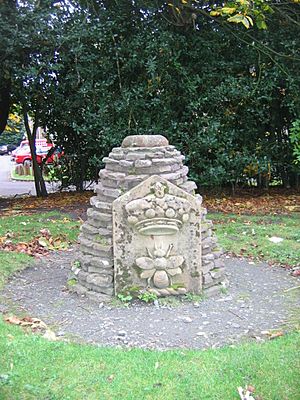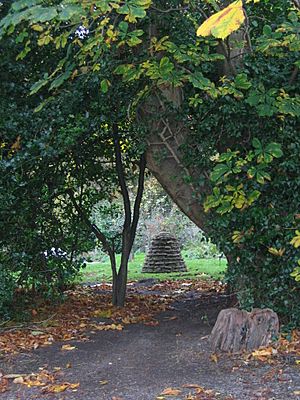Stirling Smith Art Gallery and Museum facts for kids
 |
|
| Lua error in Module:Location_map at line 420: attempt to index field 'wikibase' (a nil value). | |
| Former name | Smith Institute |
|---|---|
| Established | 1874 |
| Location | Stirling, Scotland |
| Type | Art and local history museum |
The Stirling Smith Art Gallery and Museum is a cool place in Stirling, Scotland. It's a museum that shows off art and tells the story of the local area. It used to be called The Smith Institute. An artist named Thomas Stuart Smith started it in 1874, leaving money for it in his will.
Contents
Discover the Smith Museum
How the Smith Museum Started
Thomas Stuart Smith was an artist who got to travel and paint in Italy thanks to his uncle, Alexander Smith. By the late 1840s, his artwork was shown in famous art shows in Paris and London. When his uncle passed away, Thomas inherited money. This allowed him to build a big art collection, including his own paintings.
Thomas decided he wanted to create a special place in Stirling to keep his art. He planned for it to be a library, a museum, and a reading room. He officially set up the trust in November 1869 with some friends. Sadly, he died the very next month in Avignon, so he never saw his dream come true.
When the museum's spot was chosen, many people in Stirling weren't happy. It was outside the old town walls, which made it hard to reach. People even signed a petition about it! A direct road to the Smith wasn't built until much later. Despite the worries, the Smith Institute officially opened on August 11, 1874. It was a huge celebration in Stirling, with shops closing so everyone could attend. The local leader, Provost Christie, said the location was good because it was "free from the noise and bustle" of the town, perfect for studying art and science.
Early Days and First Curators
The first person in charge of the Smith Museum was Alexander Croall (1804–1885). He was a famous natural historian from Scotland. Before coming to Stirling, he was also the first curator of the Derby City Museum. Alexander loved plants and even prepared a special collection of plants for Queen Victoria! He was so passionate about seaweeds that people called him ‘Roosty Tangle.’
Alexander Croall worked with Leonard Baker, an art teacher, to put on an art show in 1878. This led to the creation of the Stirling Fine Art Association. Croall also started the Stirling Field Club, whose members helped collect items for the museum.
When Croall passed away, his son-in-law, James Sword, became the curator (1885–1921). James was great at collecting historical items and old objects. He was also a natural historian and good at taxidermy (preparing animal specimens). He created a large collection of stuffed birds and animals. He also improved the museum grounds, adding paths and railings.
Art Shows and Music at the Smith
From 1881 to 1938, the Stirling Fine Art Association held art exhibitions at the Smith every three years. Many famous Scottish artists showed their work here, like Cadell, McTaggart, Bessie MacNicol, and Anne Redpath. Local artists also displayed their creations.
These art shows often included lectures and concerts. Young Muir Mathieson, who became a famous music director, even had his early music played here!
The Smith During World Wars
The museum's work stopped during World War I (1914-1921) and World War II (1939-1948). The building was used by soldiers for sleeping and other military needs. This caused a lot of damage to the museum. Paintings had to be crammed into small rooms to make space for the troops. There were no proper washing facilities, and food was served from a kitchen outside. The metal railings from the front of the building were even removed to help the war effort in the 1940s.
The third curator, Joseph McNaughton, worked from 1921 until the army left in 1947. With his nephew's help, he managed to publish a catalog of the museum's collections in 1934.
Soldiers and Ammunition
During both wars, one of the galleries, Gallery Three, was used to house soldiers, especially when they were training. It seems they cleaned their weapons there, as live bullets were found over the years. When the gallery was being fixed up, workers had to carefully search the heating ducts to make sure all ammunition was removed.
Saving the Smith Museum
After the wars and during the Great Depression, the money left by Thomas Stuart Smith didn't earn much interest. The building started to have serious problems. By the 1960s, it was in very poor condition.
In 1970, some important old carvings called the Stirling Heads were moved from the Smith to Stirling Castle to keep them safe. At one point, the building was so bad that people thought it might need to be torn down! But in 1973, a group of concerned citizens formed "The Friends of the Smith" to save it. They worked with the local council to rescue the building and its collections.
A big renovation project happened in the mid-1980s. During this time, they found out that the original builders had cut corners. For example, one wall was only two bricks thick but very tall! It had been held up by the roof beams for over 100 years. They had to tear it down and rebuild it properly.
Recent Years and New Additions
From 1996 to 1999, John Scott was the head of the Friends group. During this time, the Smith won an award for taking care of a painting by the composer Arcangelo Corelli. Scott also helped create popular exhibitions about William Wallace and Victorian Stirling.
Later, Margaret Gray became Chairperson. She helped create Ailie's Garden in 2002, a special outdoor area at the back of the museum for nature and play. The Friends group also grew to over 900 members! Moira Lawson, who became Chair in 2004, helped raise money for Ailie's Garden and to buy a painting of William Wallace.
John J. Coutts was the Poet in Residence at the Smith from 2015 to 2021.
The Smith Building's Design
Thomas Stuart Smith wanted to oversee the building's construction himself, but he died. Because of this, some shortcuts were taken during building. The architect, John Lessels of Edinburgh, didn't have much direct involvement.
Most of the stone for the building came from a local quarry. The front of the building has four large pillars and a triangular section above them. This section has carvings of Stirling's wolf and castle symbols. The inscription below says the building was "erected and endowed with funds bequeathed by Thomas Stuart Smith". There are six steps leading to the front door. A new metal handrail was added in 2000.
The side of the building facing Victoria Road is very long, about 218 feet (66 meters). It has two sections with three-part windows and triangular tops. These tops have bronze letters listing the trustees and architect.
The west side of the building has no windows. This was planned so that the museum could be expanded later, though this never happened. The back wall has three doors that were added during renovations in the 1980s.
The Smith building also had a home for the curator and their family until 1959. When the army took over during the wars, the curator stayed there. A separate entrance was made for their home, which is now the staff entrance.
When the Smith first opened in 1874, it had five main public areas.
- On the left of the entrance was the Reading Room and Library. This was a large room with a fancy ceiling decorated with casts of the Stirling Heads. When the library moved in 1904, this room became the natural history room. Today, it's called the Ballengeich Room or Gallery 1, and it's used for temporary art shows and the Smith Café.
- To the right was the Small Museum, which displayed the original Stirling Heads and other Scottish old objects. Later, it was used for lectures. A beautiful stained glass window was moved here in 2000.
- The middle gallery, Gallery 2, was designed for watercolor paintings. It's now used for temporary exhibitions.
- The largest gallery, Gallery 3, was for oil paintings. Today, it houses the "Stirling Story" exhibition, which tells the history of the area.
- The General Museum was on the east side, filled with museum collections. After problems with the building in the 1970s, this area became a storage space and is no longer open to the public.
When the Smith first opened, it had almost equal space for art and museum displays. However, there wasn't much space for workshops or storage. This meant that a third of the public area had to be used for storage, and most of the art collection is currently kept there. Galleries 1 and 2 are often used for changing art exhibitions by modern artists. Gallery 3, the biggest space, is currently used for the "Stirling Story" display, but it's hoped that it can return to being a large picture gallery once new storage is found.
Most of the building work for the Smith was done by local companies. However, the stone masonry and decoration were done by companies from Edinburgh.



